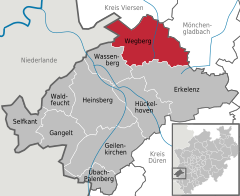Wegberg
| Wegberg | ||
|---|---|---|
|
||
| Coordinates: 51°08′N 6°16′E / 51.133°N 6.267°ECoordinates: 51°08′N 6°16′E / 51.133°N 6.267°E | ||
| Country | Germany | |
| State | North Rhine-Westphalia | |
| Admin. region | Köln | |
| District | Heinsberg | |
| Government | ||
| • Mayor | Michael Stock (SPD) | |
| Area | ||
| • Total | 84 km2 (32 sq mi) | |
| Elevation | 61 m (200 ft) | |
| Population (2015-12-31) | ||
| • Total | 27,827 | |
| • Density | 330/km2 (860/sq mi) | |
| Time zone | CET/CEST (UTC+1/+2) | |
| Postal codes | 41844 | |
| Dialling codes | 02434 | |
| Vehicle registration | HS | |
| Website | www.wegberg.de | |
Wegberg is the northernmost town in the district of Heinsberg in North Rhine-Westphalia, Germany.
Wegberg is situated between Mönchengladbach in the northeast and Erkelenz in the southeast; the town of Rheindahlen is to the east. The city lies in the Naturpark Maas-Schwalm-Nette, a nature and wildlife park hugging the border to the Netherlands. Its name derives from the three rivers that define its boundaries.
The first mention of Wegberg under the name of Berck is in a document dating from during the reign of Otto I, dated 966.
Its modern-day name appeared around the 14th century, and derives from the city's location on an old Roman road.
The many castles and defense structures (the so-called Motten, sngl. Motte) that dot the area in whole or as ruins are indications of a history of martial as well as raiding forays in and around Wegberg. One infamous stronghold that remains the focal point of many anecdotes is the castle of a robber baron located in nearby Gripekoven. The castle with its walls and swampy trenches was deemed impregnable until 1354, when it was successfully besieged and razed. Today, only a small hill hints at its former location.
From 1543 on, Wegberg was divided between the duchy of Geldern (Guelders) and the duchy of Jülich. The border ran across the city, formed by the rivers Schwalm and Beeckbach. In this period, Wegberg effectively had two mayors. Only in 1816, after the district fell to Prussia, was the division removed. In 1935 the two townships of Wegberg and Beeck were merged.
The city as it exists today emerged from the restructuring of cities and municipalities of 1972, and on July 5, 1973, Wegberg was granted the right to use the official name Stadt Wegberg ("City of Wegberg").
Eight kilometers of the city's border are also the national border of Germany and the Netherlands.
...
Wikipedia




